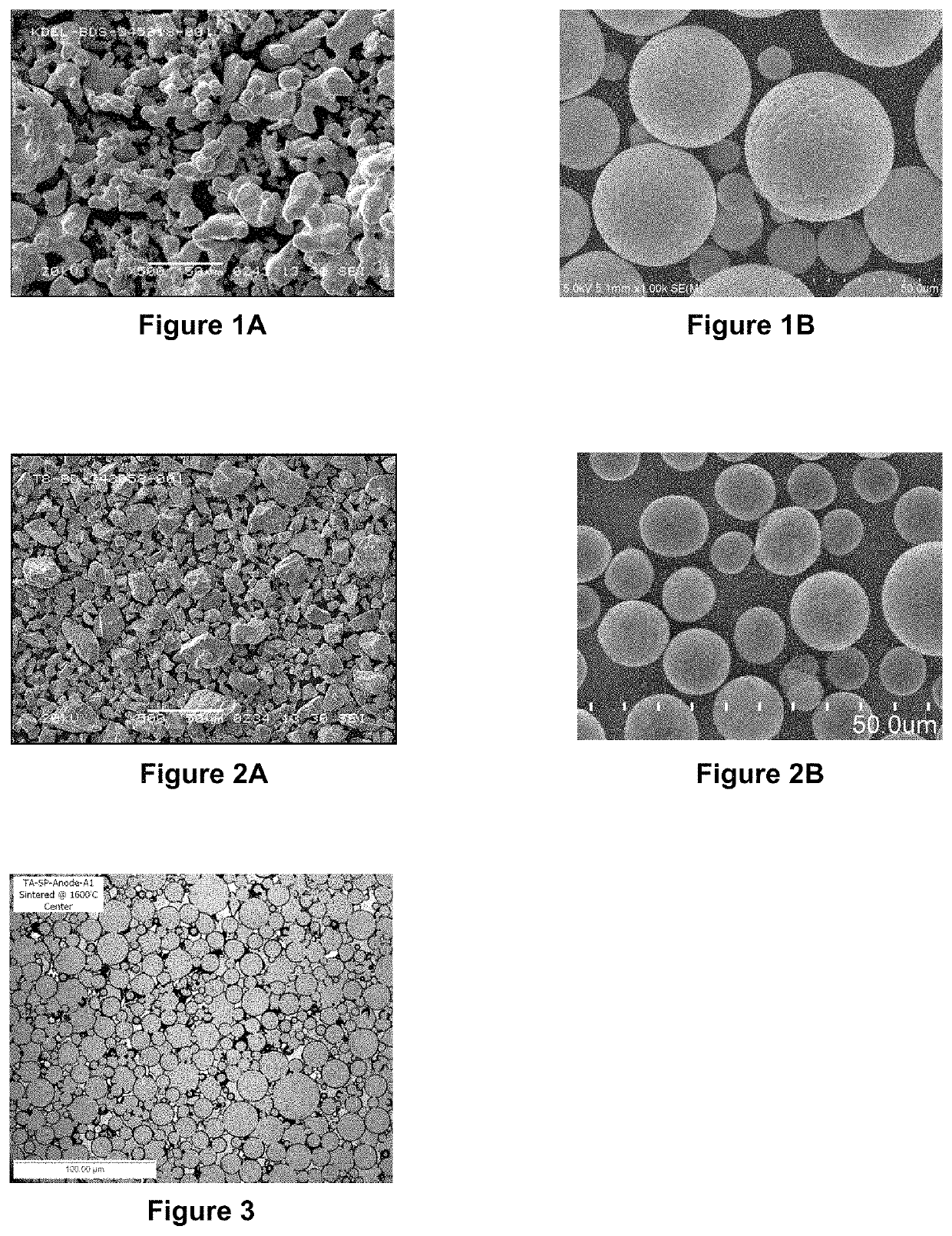Anodes containing spherical powder and capacitors
a technology of spherical powder and anodes, which is applied in the manufacture of electrolytic capacitors, electrolytic capacitors, transportation and packaging, etc., can solve the problems of high cost, time-consuming, and slow speed of ‘printing’ such anodes
- Summary
- Abstract
- Description
- Claims
- Application Information
AI Technical Summary
Benefits of technology
Problems solved by technology
Method used
Image
Examples
example 1
[0142]Commercially available KTa2F7 (KTAF) and sodium were used to obtain tantalum powder using a sodium reduction of the KTAF utilizing standard industry processes. The salt byproducts were removed by washing and acid leaching and drying steps. The resulting tantalum powder had a BET of about 0.1 m2 / g. This tantalum was a basic lot tantalum powder. FIG. 1A shows a SEM of this starting tantalum powder. The starting tantalum powder was divided into three lots of powder—Lots A, B, and C and each was separately plasma treated as described below.
[0143]Next, the basic lot tantalum powder was plasma treated. Particularly, the basic lot tantalum powder was spheroidized by introducing the basic lot tantalum powder into a feeder. The feeder had an argon supply (5 LPM) that aerosolizes the powder into the plasma spheroidization reactor (TEK15, from Tekna, Canada). The feed rate of the powder was maintained at 0.75 kg / hr by adjusting the feeder. The aerosolized powder was introduced into the p...
example 2
[0148]In this example, basic lot tantalum powder (sodium reduced powder) as in Example 1 was used. This basic lot tantalum powder had a BET of 0.1 m2 / g. The basic lot tantalum powder was pressed and sintered into green logs utilizing a sinter temperature of about 1,000 deg C. for one hour. The green logs were fed into an e-beam furnace where the metal was melted via a crucible. The melt was drawn through a die where the tantalum solidified and formed the ingot. The tantalum ingot was hydrided using a high temperature furnace with a hydrogen atmosphere and allowed to cool to room temperature after hydriding. The hydrided ingot was then crushed (using a jaw crush and then a roll crush) and screened to a sieve side of −20 #. The crushed ingot was screened to a desired size cut which was 10-25 microns for Lot A (or 35-75 microns for Lot B). The screened powder for each Lot was then acid leached. The powder was then subjected to deoxidation using magnesium to lower the oxygen levels to b...
example 3
[0152]Spherical tantalum powder was produced as in Example 2 and then anodes were formed from the powder by pressing the powder into anodes and sintering and then wet testing was performed showing a capacitance of about 2.5 kCV and electrical leakage of about 0.126 nA / CV
[0153]In more detail, feed powder used was ingot derived angular Ta powder commercially available from Global Advanced Metals USA, Inc. and known as P400 or P200H2. The angular powder was plasma spheroidized as in Example 1 using a 15 KW plasma source. The powder formed was characterized for gas impurities by LECO gas instruments for carbon, oxygen, nitrogen and hydrogen impurities. Other chemical impurities were characterized via Inductively Coupled Plasma Atomic Emission Spectroscopy (ICP). Particle size was characterized via Horiba Laser Scattering Particle Size Distribution Analyzer. The specific surface area (BET) for the resulting powder was 0.057 m2 / g. This measurement is below the specified sensitivity of the...
PUM
| Property | Measurement | Unit |
|---|---|---|
| average aspect ratio | aaaaa | aaaaa |
| particle size | aaaaa | aaaaa |
| aspect ratio | aaaaa | aaaaa |
Abstract
Description
Claims
Application Information
 Login to View More
Login to View More - R&D
- Intellectual Property
- Life Sciences
- Materials
- Tech Scout
- Unparalleled Data Quality
- Higher Quality Content
- 60% Fewer Hallucinations
Browse by: Latest US Patents, China's latest patents, Technical Efficacy Thesaurus, Application Domain, Technology Topic, Popular Technical Reports.
© 2025 PatSnap. All rights reserved.Legal|Privacy policy|Modern Slavery Act Transparency Statement|Sitemap|About US| Contact US: help@patsnap.com

